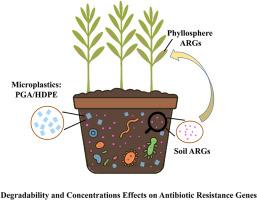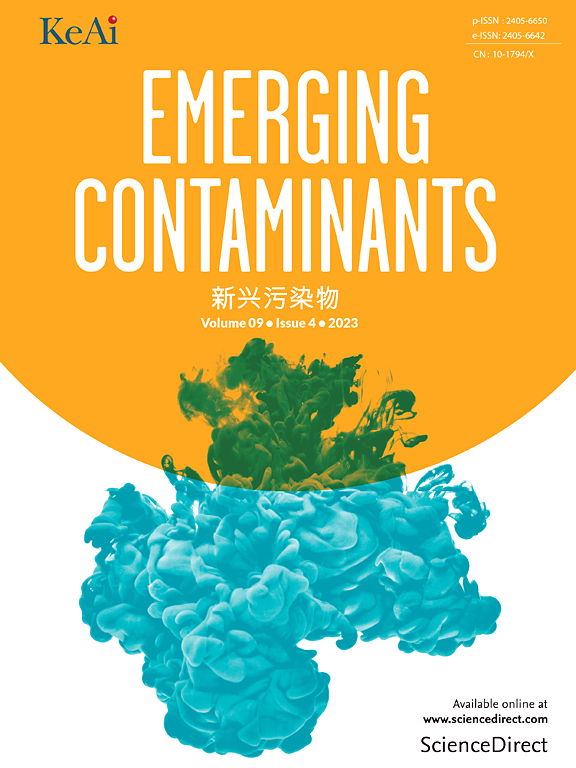Effects of microplastic degradability and concentrations on antibiotic resistance genes between soil and phyllosphere
IF 6.9
2区 环境科学与生态学
Q1 ENVIRONMENTAL SCIENCES
引用次数: 0
Abstract
Microplastics have emerged as significant environmental pollutants and notably facilitated the spread of antibiotic resistance genes (ARGs); however, their impacts and underlying mechanisms remain poorly understood. So, this study investigated the effects of different types of microplastics (biodegradable microplastics; PGA and non-degradable microplastics; HDPE) and their concentrations (0.5 %, 1.0 %, and 1.5 % w/w) on ARGs distribution and transfer between soil and the phyllosphere, utilizing a greenhouse germination experiment. The results demonstrated that microplastic addition altered the characteristics of ARGs in both soil and phyllosphere. PGA, in particular, had a more pronounced effect on ARGs abundance in the phyllosphere. In soil, ARGs abundance were jointly regulated by both microplastic type and concentration: PGA exerted a stronger influence at lower concentrations, while HDPE had a greater effect at higher concentrations. Regardless of type or concentration, microplastic addition reduced microbial network modularity, leading to substantial shifts in ARGs community structure in both soil and phyllosphere. Notably, microplastic addition at 1 % concentration yielded the highest ARGs diversity in soil. Structural equation model revealed that microplastic types and concentrations influenced ARGs transfer via distinct pathways by changing soil physicochemical properties and microbial diversity. Specifically, PGA increased soil electrical conductivity (EC) and dissolved organic carbon (DOC) to influence ARGs, while HDPE primarily affected ARGs through alterations in soil pH, available phosphorus (AP), and available potassium (AK). These findings can offer important insights into the mechanisms by which microplastics influence ARGs dissemination in terrestrial ecosystems.

微塑料降解率和浓度对土壤和层际间抗生素抗性基因的影响
微塑料已成为重要的环境污染物,特别是促进了抗生素抗性基因(ARGs)的传播;然而,它们的影响和潜在机制仍然知之甚少。因此,本研究利用温室萌发试验,研究了不同类型的微塑料(可生物降解微塑料、PGA和不可降解微塑料、HDPE)及其浓度(0.5%、1.0%和1.5% w/w)对土壤和层际间ARGs分布和转移的影响。结果表明,微塑料的添加改变了土壤和层圈中ARGs的特征。特别是PGA对层状圈中ARGs丰度的影响更为显著。在土壤中,ARGs丰度受微塑料类型和浓度的共同调节,PGA在低浓度下影响更强,而HDPE在高浓度下影响更大。无论类型或浓度如何,微塑料的添加都降低了微生物网络的模块化,导致土壤和层层圈中ARGs群落结构的实质性变化。值得注意的是,微塑料添加浓度为1%时,土壤中ARGs多样性最高。结构方程模型表明,微塑性类型和浓度通过改变土壤理化性质和微生物多样性,通过不同途径影响ARGs的转移。具体来说,PGA通过增加土壤电导率(EC)和溶解有机碳(DOC)来影响ARGs,而HDPE主要通过改变土壤pH、速效磷(AP)和速效钾(AK)来影响ARGs。这些发现可以为微塑料影响ARGs在陆地生态系统中的传播机制提供重要见解。
本文章由计算机程序翻译,如有差异,请以英文原文为准。
求助全文
约1分钟内获得全文
求助全文
来源期刊

Emerging Contaminants
Medicine-Public Health, Environmental and Occupational Health
CiteScore
10.00
自引率
6.70%
发文量
35
审稿时长
44 days
期刊介绍:
Emerging Contaminants is an outlet for world-leading research addressing problems associated with environmental contamination caused by emerging contaminants and their solutions. Emerging contaminants are defined as chemicals that are not currently (or have been only recently) regulated and about which there exist concerns regarding their impact on human or ecological health. Examples of emerging contaminants include disinfection by-products, pharmaceutical and personal care products, persistent organic chemicals, and mercury etc. as well as their degradation products. We encourage papers addressing science that facilitates greater understanding of the nature, extent, and impacts of the presence of emerging contaminants in the environment; technology that exploits original principles to reduce and control their environmental presence; as well as the development, implementation and efficacy of national and international policies to protect human health and the environment from emerging contaminants.
 求助内容:
求助内容: 应助结果提醒方式:
应助结果提醒方式:


